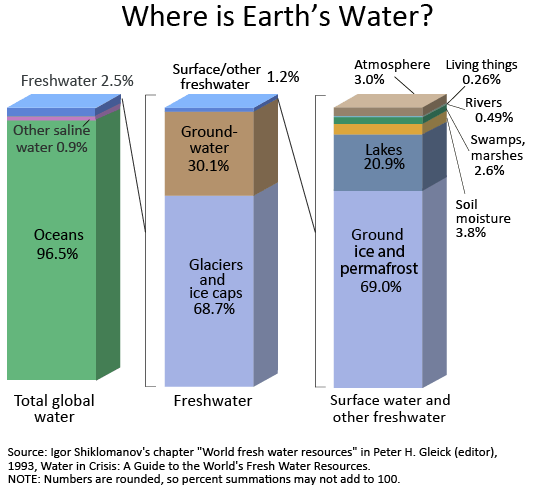The Water Cycle

Earth’s water is always in movement, and the natural water cycle, also known as the hydrologic cycle, describes the continuous movement of water on, above, and below the surface of the Earth. Water is always changing states between liquid, vapor, and ice, with these processes happening in the blink of an eye and over millions of years.
Atmosphere · Condensation · Evaporation · Evapotranspiration · Freshwater storage
Groundwater flow · Groundwater storage · Ice and snow · Infiltration · Oceans
Precipitation · Runoff · Snowmelt · Springs · Streamflow · Sublimation
Global water distribution
For an estimated explanation of where Earth’s water exists, look at the chart below. By now, you know that the water cycle describes the movement of Earth’s water, so realize that the chart and table below represent the presence of Earth’s water at a single point in time. If you check back in a thousand or million years, no doubt these numbers will be different!
Notice how of the world’s total water supply of about 332.5 million cubic miles of water, over 96 percent is saline. And, of the total freshwater, over 68 percent is locked up in ice and glaciers. Another 30 percent of freshwater is in the ground. Fresh surface-water sources, such as rivers and lakes, only constitute about 22,300 cubic miles (93,100 cubic kilometers), which is about 1/150th of one percent of total water. Yet, rivers and lakes are the sources of most of the water people use everyday.

Source: Igor Shiklomanov’s chapter “World fresh water resources” in Peter H. Gleick (editor), 1993, Water in Crisis: A Guide to the World’s Fresh Water Resources (Oxford University Press, New York).
Where is Earth’s water?
For a detailed explanation of where Earth’s water is, look at the data table below. Notice how of the world’s total water supply of about 333 million cubic miles (1,386 million cubic kilometers) of water, over 96 percent is saline. And, of the total freshwater, over 68 percent is locked up in ice and glaciers. Another 30 percent of freshwater is in the ground. Thus, rivers and lakes that supply surface water for human uses only constitute about 22,300 cubic miles (93,100 cubic kilometers), which is about 0.007 percent of total water, yet rivers are the source of most of the water people use.
| Water source | Water volume, in cubic miles | Water volume, in cubic kilometers | Percent of freshwater |
Percent of total water |
|---|---|---|---|---|
| Oceans, Seas, & Bays | 321,000,000 | 1,338,000,000 | — | 96.5 |
| Ice caps, Glaciers, & Permanent Snow | 5,773,000 | 24,064,000 | 68.7 | 1.74 |
| Groundwater | 5,614,000 | 23,400,000 | — | 1.69 |
| Fresh | 2,526,000 | 10,530,000 | 30.1 | 0.76 |
| Saline | 3,088,000 | 12,870,000 | — | 0.93 |
| Soil Moisture | 3,959 | 16,500 | 0.05 | 0.001 |
| Ground Ice & Permafrost | 71,970 | 300,000 | 0.86 | 0.022 |
| Lakes | 42,320 | 176,400 | — | 0.013 |
| Fresh | 21,830 | 91,000 | 0.26 | 0.007 |
| Saline | 20,490 | 85,400 | — | 0.006 |
| Atmosphere | 3,095 | 12,900 | 0.04 | 0.001 |
| Swamp Water | 2,752 | 11,470 | 0.03 | 0.0008 |
| Rivers | 509 | 2,120 | 0.006 | 0.0002 |
| Biological Water | 269 | 1,120 | 0.003 | 0.0001 |
| Source: Igor Shiklomanov’s chapter “World fresh water resources” in Peter H. Gleick (editor), 1993, Water in Crisis: A Guide to the World’s Fresh Water Resources (Oxford University Press, New York). | ||||
Source: USGS.gov
The Clear H2O Method

Assess
AWWT conducts preliminary assessments of your systems, facility, and processes to determine productive methods for wastewater removal, management, and treatment.

Control
Through a patented technology, AWWT will implement the most effective treatments based on our investigatory findings and your wastewater management needs.

Safeguard
Collectively we will achieve and maintain “green and clean” solutions through protection and management planning of your future wastewater treatment methods.
Read blog

"San Francisco Wants To Lead The Future In Water And Wastewater Resources"
Few organizations are in a better position to affect our approach to c...Read More >>

"Harvey Leaves Challenges In Texas, From Drinking Water To Rent Payments"
Harvey is finally out of the picture — but the storm's dev...Read More >>

"The Water Cycle"
Earth's water is always in movement, and the natural water cycle, also...Read More >>
